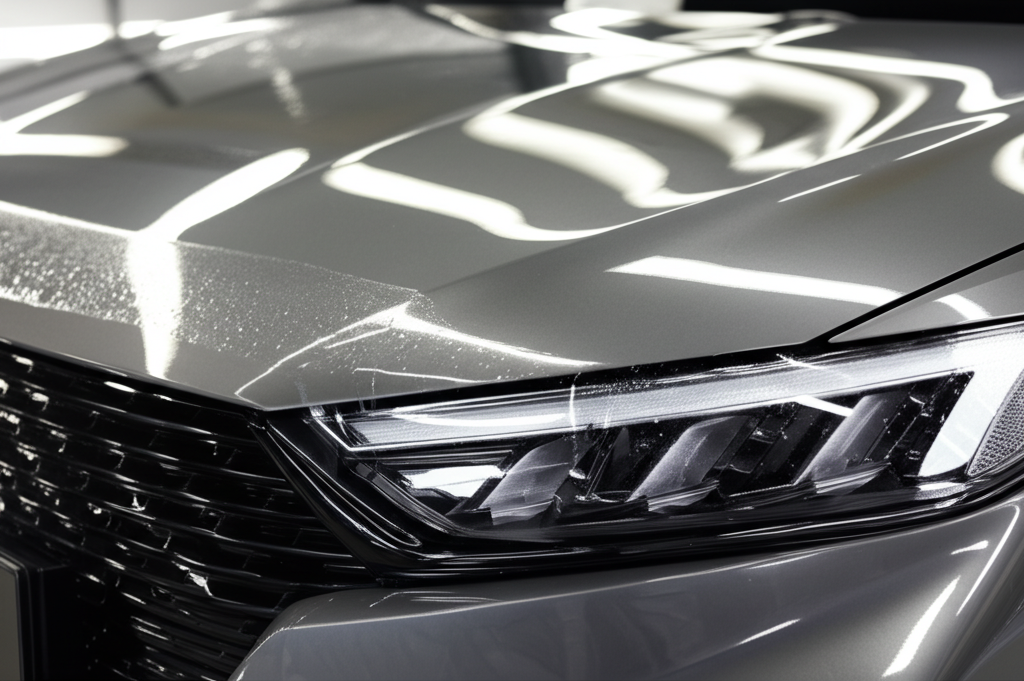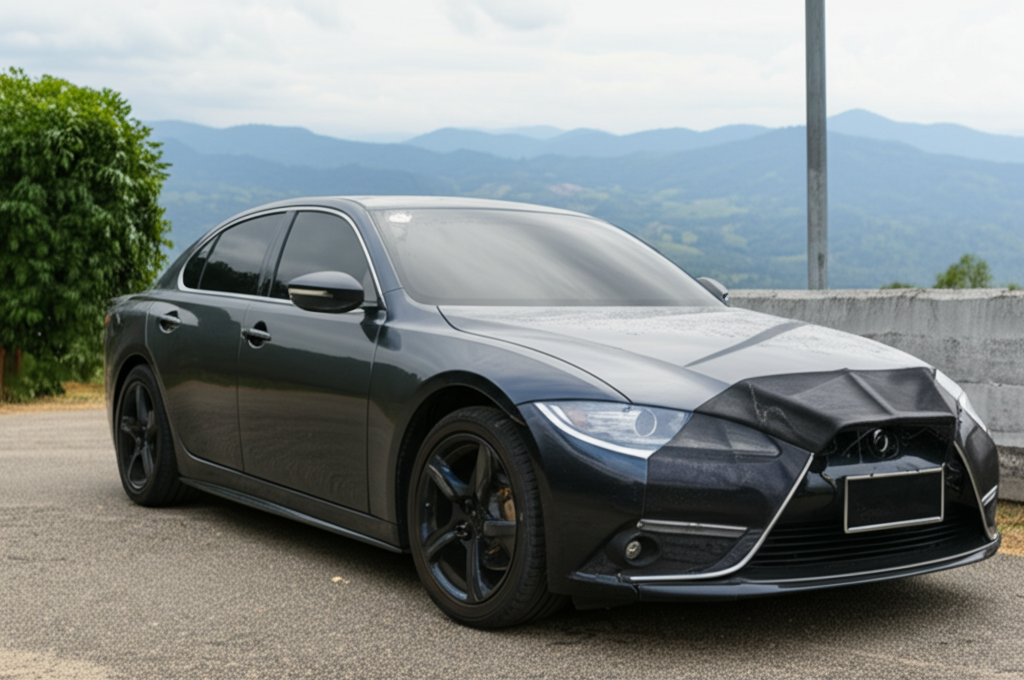Let’s be honest, getting your first car, or even your ‘new-to-you’ car, is a massive deal! It’s freedom, it’s style, it’s your pride and joy cruising through the vibrant streets of Bangkok, Chiang Mai, or maybe down south to the beaches. But then comes the worry… the chaotic traffic, the stray gravel on highways, unexpected parking lot encounters, and even the harsh Thai sun. You want to keep that paint looking showroom fresh, right? You’ve probably heard whispers about “invisible car bras” or “paint protection film,” especially this fancy thing called TPU PPF. People say it’s the best, offering amazing protection. But then you hear the price, and your wallet starts sweating. You think, “Wow, that’s a lot of Baht! Is it *really* worth it, and how long will this expensive protection actually last?” You’re not alone in wondering if this high-tech shield is just hype or a smart investment, especially when you’re young and managing your budget carefully.

Nat, a recent university graduate working his first job in Bangkok, finally bought his dream second-hand Honda Civic. He loved the car’s sleek look and was meticulous about keeping it clean. However, his daily commute through congested city roads and occasional trips upcountry quickly introduced him to the harsh realities of driving in Thailand. A rogue shopping cart left a faint scratch on his door, and a piece of debris kicked up by a truck on the highway left a tiny chip on the hood. Each small imperfection felt like a major blow.
He started researching ways to protect his car’s paint. Friends recommended waxing, but Nat knew that offered minimal protection against physical damage. He then stumbled upon Paint Protection Film (PPF). Initially, he looked at cheaper PVC options, tempted by the lower price tag. But after reading reviews and watching videos, he noticed common complaints about PVC films yellowing quickly under the Thai sun, cracking over time, and sometimes even damaging the paint upon removal. Then he learned about TPU (Thermoplastic Polyurethane) film. The benefits sounded amazing: self-healing from minor scratches, incredible clarity, stain resistance, and long-lasting protection. The catch? The price was significantly higher.
Nat was hesitant. It felt like a huge expense for someone just starting their career. Could he justify spending that much on a ‘plastic film’? He visited a reputable installer who explained the process, showed him samples of TPU quality, and detailed the warranty (often 5-10 years for premium TPU). They explained that the cost wasn’t just the film itself, but also the meticulous, highly skilled labour required for a flawless, bubble-free installation that covers edges properly. Seeing a car mid-installation and the care taken convinced him. Nat decided to view it as an investment in preserving his car’s value and his own peace of mind. He opted for a partial front-end package (hood, fenders, bumper, mirrors) to balance protection and budget. Weeks later, after navigating countless traffic jams and even finding a small scuff mark that vanished after parking in the sun (thanks to the self-healing!), Nat knew he’d made the right choice. The anxiety about paint damage was gone, replaced by confidence and pride in his protected ride.

So, what exactly makes TPU PPF command a higher price compared to other options like PVC (Polyvinyl Chloride) films or even frequent waxing/ceramic coatings? It boils down to the material science, manufacturing complexity, and performance benefits.
TPU is an advanced polymer known for its elasticity, transparency, resistance to abrasion, and crucially, its ability to ‘self-heal’ minor scratches when exposed to heat (like the sun or warm water). Cheaper PVC films are essentially a harder plastic. While they might offer some initial barrier, they lack the flexibility and resilience of TPU. They tend to become brittle over time, especially under strong UV exposure (a major factor in Thailand!), leading to yellowing, cracking, and potentially damaging the paint underneath if left on too long or removed improperly.
Let’s break down the key differences in a table:
| Feature | Premium TPU PPF | PVC/Vinyl Film | Wax / Sealant |
|---|---|---|---|
| Material | Thermoplastic Polyurethane | Polyvinyl Chloride | Carnauba, Synthetic Polymers |
| Primary Function | Impact & Scratch Protection, Self-Healing, Stain Resistance | Basic Scratch Resistance (limited), Colour Change/Cosmetic | Gloss Enhancement, Hydrophobicity, Minor UV Protection |
| Self-Healing (Minor Scratches) | Yes (with heat) | No | No |
| Clarity & Non-Yellowing | Excellent, highly resistant to yellowing | Can yellow/discolour, especially under strong UV (like Thailand’s sun) | N/A (temporary coating) |
| Durability & Flexibility | High, very flexible, conforms to curves well | Lower, can become brittle, may crack | Very low durability (wears off) |
| Typical Lifespan (Thailand Conditions) | 5-10+ years (with proper care & quality film) | 1-3 years (can degrade faster) | Weeks to Months |
| Protection Level | Excellent against stone chips, minor scratches, bug splatter, bird droppings, environmental fallout | Minimal protection against impacts, some light scratch resistance | Minimal physical protection, primarily cosmetic and water-beading |
| Installation Complexity | High (Requires skilled professionals, specific tools, clean environment) | Moderate to High (Depends on application, less forgiving than TPU) | Low (DIY possible) |
| Estimated Price Range (Full Front End – Thailand) | ฿20,000 – ฿50,000+ (depending on car size, film brand, coverage) | ฿5,000 – ฿15,000 (often for colour change vinyl, not true PPF) | ฿500 – ฿3,000 (per application) |
| Best For | Owners seeking long-term, comprehensive paint protection, maintaining resale value, peace of mind. Essential for high-risk areas (front bumper, hood). | Short-term cosmetic changes (colour wraps), very limited budget with understanding of downsides. Not ideal for pure paint protection. | Regular maintenance enthusiasts, enhancing gloss between washes. Not a primary protection method. |
Why the High Cost?
- Raw Materials: High-quality polyurethane resins and top coats (for self-healing, stain resistance) are inherently more expensive to produce than basic PVC.
- Research & Development: Leading brands invest heavily in R&D to improve film clarity, durability, adhesive technology, and self-healing properties.
- Manufacturing Process: Creating a multi-layered film with consistent thickness, clarity, and adhesive properties is a complex, precision-controlled process.
- Skilled Installation: Applying PPF correctly is an art form. It requires patience, precision, specialized tools, and a dust-free environment. Labour costs for trained installers are a significant part of the price, ensuring a finish that looks invisible and lasts long. Poor installation can lead to bubbles, peeling edges, and a shorter lifespan.
- Warranty: Reputable TPU brands offer substantial warranties (often 5, 7, or 10 years) against yellowing, bubbling, cracking, or staining, adding to the value proposition.
Hearing from peers can make a big difference. Here’s what some young car owners in Thailand shared after getting TPU PPF:
“Honestly, I nearly choked when I saw the initial quote for full front TPU. My friends said I was crazy spending that much on my Vios. But after just six months, I saw tiny rock chips pepper the front of my friend’s unprotected car. Mine? Still perfect. That daily relief driving through construction zones is priceless. No regrets!”
– Pim, 25, Marketing Executive, Bangkok
“I live near the beach in Phuket, so it’s not just scratches, but also the salt air and bird droppings. I chose a quality TPU film mainly for the stain resistance and UV protection. Washing the car is so much easier now, everything just slides off. Before, I was always stressed about permanent marks. Now, I just enjoy the drive.”
– Alex, 28, Hotel Manager, Phuket
“My budget was tight, so I only did the bumper and headlights with TPU on my Mazda2. It seemed like the highest impact areas. Last month, someone carelessly scraped my bumper while parking. I was devastated, but the film took the hit! There was a mark on the PPF, but the paint underneath was untouched. The installer replaced that small section for a fraction of a repaint cost. It already paid for itself!”
– Meena, 23, Student, Chiang Mai
The common theme? Initial budget concerns transformed into long-term satisfaction and relief. They see it less as an expense and more as insurance for their car’s appearance and value.
Worried about navigating the costs and options for TPU PPF in Thailand? We get it. Protecting your car shouldn’t be confusing. If you’re curious about how TPU PPF can safeguard your specific car model against Thai road conditions and fit within a reasonable budget, let’s chat. We can provide personalized advice and a transparent quote tailored to your needs.
Don’t let the fear of scratches diminish the joy of owning your car. Find out how affordable long-term protection can be.
📱 Want to learn more about car wrap & paint protection?
Feel free to reach us on LINE:

🌐 Official Website: https://tpuwraps.com
- Q: Is TPU PPF really necessary for driving in Thailand?
- A: While not mandatory, it’s highly recommended given the typical driving conditions. High traffic density increases the risk of minor bumps and scrapes. Road debris on highways is common, causing stone chips. Intense sun can degrade paint, and environmental factors like bird droppings and tree sap can cause etching. TPU PPF provides a robust barrier against all these common issues, helping maintain your car’s look and value.
- Q: How long does quality TPU PPF *actually* last in the Thai climate?
- A: Reputable TPU films from established brands, when professionally installed and reasonably maintained (regular washing, avoiding harsh chemicals), typically last between 5 to 10 years, sometimes even longer. Most come with warranties covering defects like yellowing, cracking, or bubbling for a significant portion of this period. Cheaper, lower-quality TPU or PVC films will have a much shorter lifespan, especially under intense UV exposure.
- Q: Can I save money by installing PPF myself?
- A: We strongly advise against DIY installation for TPU PPF. It requires a very clean environment, specialized tools (squeegees, slip solution, heat gun), and significant skill to stretch and apply the film without bubbles, creases, or contamination. A poor installation wastes expensive material and won’t provide optimal protection or appearance. Professional installation ensures a flawless finish and usually validates the manufacturer’s warranty.
- Q: Will TPU PPF damage my car’s original paint?
- A: High-quality TPU PPF applied and removed correctly by professionals will NOT damage your factory paint. The adhesives used are designed to be strong yet removable without leaving residue or pulling paint. Problems usually arise only with very low-quality films or improper removal techniques (e.g., using excessive heat or scraping). Ensure your car’s paint is in good condition (no peeling or failing clear coat) before application.
- Q: Are there different ‘levels’ or thicknesses of TPU PPF?
- A: Yes. Standard TPU PPF is typically around 6-8 mils (0.15-0.20 mm) thick, which is sufficient for most road hazards. Some brands offer thicker options (e.g., 10-12 mils) for extra protection in very high-impact areas or for off-road vehicles. Additionally, different top coats offer varying levels of gloss, hydrophobicity (water-repellency), and self-healing speed. Discuss your needs and driving habits with the installer to choose the right film.
Thinking about TPU PPF purely in terms of upfront cost misses the bigger picture. Yes, the initial investment is higher than a bottle of wax or a cheaper vinyl film. But consider what you’re buying: years of protection against the daily grind of Thai roads, defence against costly paint chips and scratches, easier maintenance, and the preservation of your car’s resale value. Most importantly, you’re buying peace of mind. No more wincing at flying gravel or nervously inspecting your car after parking in a tight spot.
For a young owner on a budget, protecting your asset smartly is key. TPU PPF isn’t just a cosmetic add-on; it’s a functional investment that safeguards your car’s condition and your enjoyment of it for years to come. Instead of potentially facing expensive repaint bills down the line, you make a one-time investment for long-lasting defence. So, while the price tag might seem daunting initially, understanding the technology, longevity, and real-world benefits reveals the true value proposition of TPU PPF.
Ready to give your car the invisible shield it deserves? Explore your options and drive with confidence!

